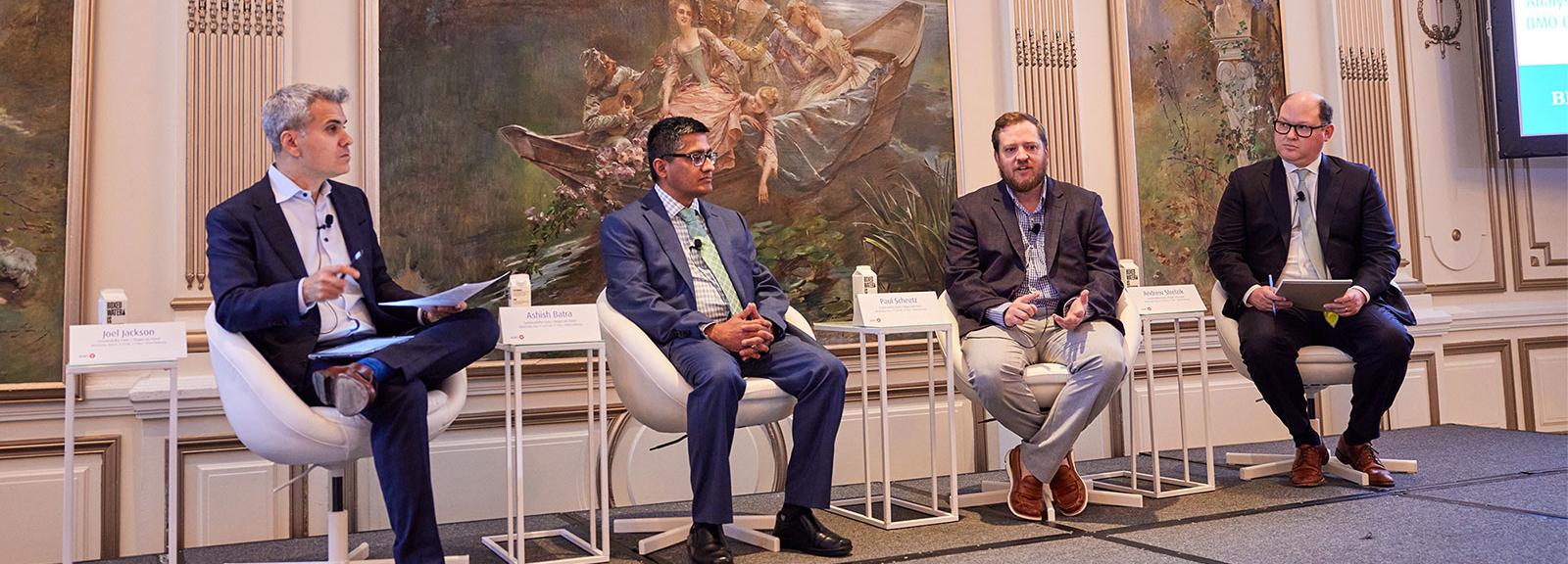
Is Regenerative Agriculture the Future of Farming?
-
bookmark
-
print
As conversations around reducing emissions intensify across the agricultural industry, there’s a growing focus on the benefits of sustainable farming and regenerative agriculture. With more food suppliers and growers adopting these practices, some industry leaders see this approach as an opportunity to accelerate the transition.
How to build on that momentum drove much of the conversation during a panel at the BMO Capital Markets 18th annual Farm to Market Conference in New York. The session was moderated by Joel Jackson, Fertilizers and Chemicals Analyst, and Andrew Strelzik, Restaurants, Beverages, Agribusiness and Protein Analyst at BMO Equity Research. They were joined by Paul Scheetz, Director Climate Smart Ag Origination, Archer Daniels Midland (ADM), a company that focuses on the farmers and purchases crops and transforms them into food, fuel, or feed, and Ashish Batra, Global Regulatory Affairs Research & Development Sustainability Leader, Corteva Agriscience, which offers farmers cutting edge seed technologies and digitally enabled crop protection solutions.
Defining Regenerative Agriculture
Joel Jackson started the conversation by asking: What is regenerative agriculture? He noted that although there is no widely accepted definition yet, in essence, it is the practice of farming and ranching using methods that rehabilitate the soil and surrounding ecosystem.
Corteva’s Batra pointed out that while the details of its execution may not be universally agreed upon, the industry recognizes that regenerative agriculture enhances the entire value chain. “The focus really needs to be on outcomes,” he explained. “You’re trying to drive towards better biodiversity; you’re trying to drive towards better soil health, better water use, and efficiencies.” He added that the regenerative agriculture solutions that will deliver those outcomes will differ region by region.
Incentivizing Adoption
The Inflation Reduction Act (IRA) has been one of the most recent drivers encouraging the adoption of regenerative farming practices in the United States. With nearly $20 billion earmarked to be invested in climate-smart agriculture over the next five years, both Scheetz and Batra agreed the IRA could serve as a significant incentive for farmers to make the transition.
“The IRA bill also includes the ability to score field-level emissions for the carbon intensity of the plants that we will ultimately use for biodiesel, ethanol and potentially SAF (sustainable aviation fuels) in the future,” noted Scheetz.
It’s not a one-size-fits-all approach; at the end of the day, every farm is different. What works for one, like cover crops, which are plants used to manage soil erosion and water rather than for harvesting, won’t work for every farm. “It takes coordination across the agriculture supply chain farmer groups, industry groups, along with legislators as well to make sure they can see the whole picture,” he added.
Both Scheetz and Batra agreed that regulators in the U.S. and abroad need to embrace the idea of individualized approaches to regenerative agriculture. “We have a guiding principle within our organization to think globally but act locally because all regulatory policies are done at the local level,” explained Batra. He pointed to the difference between regenerative practices needed for rice paddies in Asia, versus row crops in North or South America. “We look at it holistically — it needs to be a fit for the purpose, a fit for the geography.”
The Missing Pieces
Fortunately, there have been gains in all areas of regenerative agriculture, especially in the U.S. Over the past 40 years, no-till farming, which decreases the amount of erosion farming causes in certain soils, has increased to more than 100 million acres from less than two million acres. A similar transformation is happening with cover crops, which in 2020 reached approximately 20 million acres — a 20-fold increase since 2000. However, much remains to be done to speed up that adoption, especially when it comes to addressing farmers’ concerns.
“With every region you’re in, you have to do that analysis to understand what’s missing, what’s the concern,” noted Scheetz. “And today, with farmers, most of their decisions are made on productivity and costs. So, there are a lot of co-benefits that come with these practices, or perceived production risks or cost risks that have to be overcome.”
The Promise of Regenerative Agriculture
Consumer demand will also begin to drive more adoption as a larger proportion of the population understands the value of regenerative agriculture. ADM has seen an increase in consumer inquiries related to sustainable farming practices, and Scheetz noted that this will only grow as customers begin to recognize the importance of Scope 3 carbon emissions in the supply chain.
“There’s this perfect storm of all of these industries looking for a carbon solution and being tied to the ingredients that we ultimately sell,” he explained. “And we do have a solution.”
According to Batra, convincing food and agriculture companies to invest in regenerative policies will also mean acknowledging that to achieve these outcomes, the industry must focus on marrying practices that make sense for the growers with the new agriculture technologies.
“At its core,” Scheetz noted, “regenerative agriculture is a good investment because ultimately, everyone depends on the land to produce the ingredients used to create whichever final product is put on the market.”
Scheetz said regenerative agriculture is as important to the industry as it is to the environment. “The regenerative agriculture practices we’re trying to incentivize increase the resiliency in an ever-changing climate going forward,” he noted. “It’s a good investment ultimately for ourselves as well (as the farmers who) depend on the land used to produce the ingredients and the finished products.”
While the research and science behind regenerative agriculture is expected to improve over the next few years, he said the industry can’t afford to wait. “Progress over perfection,” he said. “You cannot just scale up in 2030 to achieve the commitments you’ve ultimately made. It takes time, and the best way to learn is to engage on these programs.”

Is Regenerative Agriculture the Future of Farming?
Equity Research Analyst, Fertilizers and Chemicals
Joel is a senior analyst in BMO Capital Markets Equity Research, covering the chemicals and fertilizer/ag sectors. Joel joined BMO in 2006, and has been a publishin…
Restaurant Analyst
Andrew is a senior analyst in BMO Capital Markets Equity Research, covering restaurants. In 2015, 2016 and 2017, Andrew was named an “All-America Research Tea…
Joel is a senior analyst in BMO Capital Markets Equity Research, covering the chemicals and fertilizer/ag sectors. Joel joined BMO in 2006, and has been a publishin…
VIEW FULL PROFILEAndrew is a senior analyst in BMO Capital Markets Equity Research, covering restaurants. In 2015, 2016 and 2017, Andrew was named an “All-America Research Tea…
VIEW FULL PROFILE-
Minute Read
-
Listen
Stop
-
Text Bigger | Text Smaller
As conversations around reducing emissions intensify across the agricultural industry, there’s a growing focus on the benefits of sustainable farming and regenerative agriculture. With more food suppliers and growers adopting these practices, some industry leaders see this approach as an opportunity to accelerate the transition.
How to build on that momentum drove much of the conversation during a panel at the BMO Capital Markets 18th annual Farm to Market Conference in New York. The session was moderated by Joel Jackson, Fertilizers and Chemicals Analyst, and Andrew Strelzik, Restaurants, Beverages, Agribusiness and Protein Analyst at BMO Equity Research. They were joined by Paul Scheetz, Director Climate Smart Ag Origination, Archer Daniels Midland (ADM), a company that focuses on the farmers and purchases crops and transforms them into food, fuel, or feed, and Ashish Batra, Global Regulatory Affairs Research & Development Sustainability Leader, Corteva Agriscience, which offers farmers cutting edge seed technologies and digitally enabled crop protection solutions.
Defining Regenerative Agriculture
Joel Jackson started the conversation by asking: What is regenerative agriculture? He noted that although there is no widely accepted definition yet, in essence, it is the practice of farming and ranching using methods that rehabilitate the soil and surrounding ecosystem.
Corteva’s Batra pointed out that while the details of its execution may not be universally agreed upon, the industry recognizes that regenerative agriculture enhances the entire value chain. “The focus really needs to be on outcomes,” he explained. “You’re trying to drive towards better biodiversity; you’re trying to drive towards better soil health, better water use, and efficiencies.” He added that the regenerative agriculture solutions that will deliver those outcomes will differ region by region.
Incentivizing Adoption
The Inflation Reduction Act (IRA) has been one of the most recent drivers encouraging the adoption of regenerative farming practices in the United States. With nearly $20 billion earmarked to be invested in climate-smart agriculture over the next five years, both Scheetz and Batra agreed the IRA could serve as a significant incentive for farmers to make the transition.
“The IRA bill also includes the ability to score field-level emissions for the carbon intensity of the plants that we will ultimately use for biodiesel, ethanol and potentially SAF (sustainable aviation fuels) in the future,” noted Scheetz.
It’s not a one-size-fits-all approach; at the end of the day, every farm is different. What works for one, like cover crops, which are plants used to manage soil erosion and water rather than for harvesting, won’t work for every farm. “It takes coordination across the agriculture supply chain farmer groups, industry groups, along with legislators as well to make sure they can see the whole picture,” he added.
Both Scheetz and Batra agreed that regulators in the U.S. and abroad need to embrace the idea of individualized approaches to regenerative agriculture. “We have a guiding principle within our organization to think globally but act locally because all regulatory policies are done at the local level,” explained Batra. He pointed to the difference between regenerative practices needed for rice paddies in Asia, versus row crops in North or South America. “We look at it holistically — it needs to be a fit for the purpose, a fit for the geography.”
The Missing Pieces
Fortunately, there have been gains in all areas of regenerative agriculture, especially in the U.S. Over the past 40 years, no-till farming, which decreases the amount of erosion farming causes in certain soils, has increased to more than 100 million acres from less than two million acres. A similar transformation is happening with cover crops, which in 2020 reached approximately 20 million acres — a 20-fold increase since 2000. However, much remains to be done to speed up that adoption, especially when it comes to addressing farmers’ concerns.
“With every region you’re in, you have to do that analysis to understand what’s missing, what’s the concern,” noted Scheetz. “And today, with farmers, most of their decisions are made on productivity and costs. So, there are a lot of co-benefits that come with these practices, or perceived production risks or cost risks that have to be overcome.”
The Promise of Regenerative Agriculture
Consumer demand will also begin to drive more adoption as a larger proportion of the population understands the value of regenerative agriculture. ADM has seen an increase in consumer inquiries related to sustainable farming practices, and Scheetz noted that this will only grow as customers begin to recognize the importance of Scope 3 carbon emissions in the supply chain.
“There’s this perfect storm of all of these industries looking for a carbon solution and being tied to the ingredients that we ultimately sell,” he explained. “And we do have a solution.”
According to Batra, convincing food and agriculture companies to invest in regenerative policies will also mean acknowledging that to achieve these outcomes, the industry must focus on marrying practices that make sense for the growers with the new agriculture technologies.
“At its core,” Scheetz noted, “regenerative agriculture is a good investment because ultimately, everyone depends on the land to produce the ingredients used to create whichever final product is put on the market.”
Scheetz said regenerative agriculture is as important to the industry as it is to the environment. “The regenerative agriculture practices we’re trying to incentivize increase the resiliency in an ever-changing climate going forward,” he noted. “It’s a good investment ultimately for ourselves as well (as the farmers who) depend on the land used to produce the ingredients and the finished products.”
While the research and science behind regenerative agriculture is expected to improve over the next few years, he said the industry can’t afford to wait. “Progress over perfection,” he said. “You cannot just scale up in 2030 to achieve the commitments you’ve ultimately made. It takes time, and the best way to learn is to engage on these programs.”
Highlights from our BMO Global Farm to Market Conference
PART 1
BMO Experts at our 18th Annual Farm to Market Conference
May 31, 2023
Our annual Farm to Market Conference is an industry-leading event bringing together global leaders to discuss the future of the agriculture…
PART 2
Food, Ag, Fertilizer, and ESG From BMO’s 18th Annual Farm to Market Conference
Dan Barclay May 31, 2023
In this episode from BMO Equity Research IN Tune Podcast, we are joined by BMO Capital Markets’ CEO & Group Head Dan Barclay as h…
PART 3
Reducing Food Waste: Solutions, Opportunities and Impact
Doug A. Morrow May 26, 2023
If you want to get a sense of the scope of food waste, just look at the numbers. According to the Food and Drug Administration, food waste …
PART 4
The M&A Environment: Where Is It Headed?
Warren Estey, Amit Melwani May 26, 2023
"The macro environment continues to be complex. The cross-currents of Fed policy, economic growth, inflation and geopolitics, combined…
PART 6
Private Equity Is Still in Risk-on Mode, but It’s Picking Its Spots
Michael Cippoletti May 26, 2023
Private equity firms are taking market uncertainty and higher capital costs in stride. While transaction levels are down year-over-ye…
PART 7
Growth of the Carbon Market: Considerations from Key Stakeholders
Jonathan Hackett June 01, 2023
With the global compliance carbon market worth more than US$900 billion and the voluntary market forecasted to reach as much as $40 billion…
Conference
May 15, 2024 | New York
Email UsYou might also be interested in
Food, Ag, Fertilizer, and ESG From BMO’s 19th Annual Farm to Market Conference: BMO Equity Research
Private Equity Finds Comfort Amid Uncertainty in Agribusiness Sector
IN Tune: Food, Ag, Fertilizer, and ESG From BMO’s 19th Annual Farm to Market Conference
Glass Half Full or Half Empty? Despite Headwinds, a Majority of U.S. Wine Businesses See a Recovery Ahead
The Future of Food: Global Food and Agriculture Trends and Outlook BMO Hosts 19th Farm to Market | Chemicals Conference in New York

Women are Leading Across the Landscape of Climate and Sustainability
BMO Establishes new U.S. Wine Industry Partnership, Enhancing Offering for Wine and Spirits Industry
Canada Has an Opportunity to Become a Global Leader in Carbon Dioxide Removal

Extreme Temperatures: How North American Cities Amplify Climate Change
Three Keys to Unlocking Energy Transition: Partnerships, Permitting, and Finance
How the Energy Sector Is Helping Canada Achieve Its Decarbonization Goals
Transforming the Global Food System to Benefit Investors and the Planet

Quick Listen: Darryl White on the Importance of US-Canada Partnership

Food, Ag, Fertilizer, and ESG From BMO’s 18th Annual Farm to Market Conference
Private Equity Is Still in Risk-on Mode, but It’s Picking Its Spots
Global Food and Agriculture Trends and Outlook: BMO Hosts 18th Farm to Market | Chemicals Conference in New York
Driving Innovations In Tech To Strengthen Climate Resilience With Climate Engine’s Spatiafi, Built On Google Cloud
BMO Donates $2 Million to the University of Saskatchewan to Accelerate Research Critical to the Future of Food
North American Agriculture’s Role in Meeting the Global Food Insecurity Challenge – US-Canada Summit
Not All Carbon Credits Created Equal: BMO Global Metals, Mining & Critical Minerals Conference
Is Green Financing for Nuclear the Next Frontier in the Energy Transition?
Exploring the Physical and Transition Risks Facing Food and Agriculture
BMO Hosts World-Leading Farm to Market Conference for 16th Consecutive Year
The Future of Food & Agriculture: BMO Hosts World-Leading Farm to Market Conference for 16th Consecutive Year













